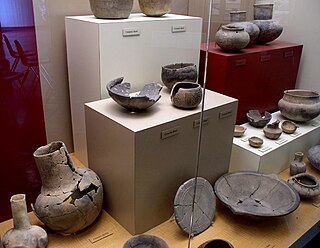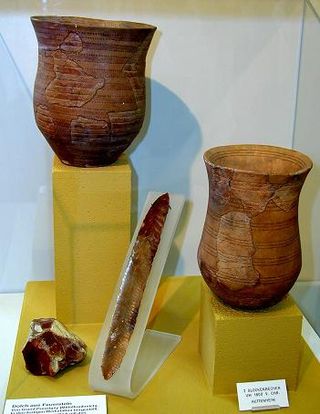Related Research Articles

Vere Gordon Childe was an Australian archaeologist who specialised in the study of European prehistory. He spent most of his life in the United Kingdom, working as an academic for the University of Edinburgh and then the Institute of Archaeology, London. He wrote twenty-six books during his career. Initially an early proponent of culture-historical archaeology, he later became the first exponent of Marxist archaeology in the Western world.

Processual archaeology is a form of archaeological theory that had its beginnings in 1958 with the work of Gordon Willey and Philip Phillips, Method and Theory in American Archaeology, in which the pair stated that "American archaeology is anthropology, or it is nothing", a rephrasing of Frederic William Maitland's comment: "My own belief is that by and by, anthropology will have the choice between being history, and being nothing." The idea implied that the goals of archaeology were, in fact, the goals of anthropology, which were to answer questions about humans and human culture. That was a critique of the former period in archaeology, the cultural-history phase in which archaeologists thought that any information that artifacts contained about past people and past ways of life would be lost once the items became included in the archaeological record. All they felt could be done was to catalogue, describe, and create timelines based on the artifacts.
Post-processual archaeology, which is sometimes alternately referred to as the interpretative archaeologies by its adherents, is a movement in archaeological theory that emphasizes the subjectivity of archaeological interpretations. Despite having a vague series of similarities, post-processualism consists of "very diverse strands of thought coalesced into a loose cluster of traditions". Within the post-processualist movement, a wide variety of theoretical viewpoints have been embraced, including structuralism and Neo-Marxism, as have a variety of different archaeological techniques, such as phenomenology.
Systems theory in archaeology is the application of systems theory and systems thinking in archaeology. It originated with the work of Ludwig von Bertalanffy in the 1950s, and is introduced in archaeology in the 1960s with the work of Sally R. Binford & Lewis Binford's "New Perspectives in Archaeology" and Kent V. Flannery's "Archaeological Systems Theory and Early Mesoamerica".
Lewis Roberts Binford was an American archaeologist known for his influential work in archaeological theory, ethnoarchaeology and the Paleolithic period. He is widely considered among the most influential archaeologists of the later 20th century, and is credited with fundamentally changing the field with the introduction of processual archaeology in the 1960s. Binford's influence was controversial, however, and most theoretical work in archaeology in the late 1980s and 1990s was explicitly construed as either a reaction to or in support of the processual paradigm. Recent appraisals have judged that his approach owed more to prior work in the 1940s and 50s than suggested by Binford's strong criticism of his predecessors.

Culture-historical archaeology is an archaeological theory that emphasises defining historical societies into distinct ethnic and cultural groupings according to their material culture.
An archaeological culture is a recurring assemblage of types of artifacts, buildings and monuments from a specific period and region that may constitute the material culture remains of a particular past human society. The connection between these types is an empirical observation, but their interpretation in terms of ethnic or political groups is based on archaeologists' understanding and interpretation and is in many cases subject to long-unresolved debates. The concept of the archaeological culture is fundamental to culture-historical archaeology.
Ethnoarchaeology is the ethnographic study of peoples for archaeological reasons, usually through the study of the material remains of a society. Ethnoarchaeology aids archaeologists in reconstructing ancient lifeways by studying the material and non-material traditions of modern societies. Ethnoarchaeology also aids in the understanding of the way an object was made and the purpose of what it is being used for. Archaeologists can then infer that ancient societies used the same techniques as their modern counterparts given a similar set of environmental circumstances.
Cognitive archaeology is a theoretical perspective in archaeology that focuses on the ancient mind. It is divided into two main groups: evolutionary cognitive archaeology (ECA), which seeks to understand human cognitive evolution from the material record, and ideational cognitive archaeology (ICA), which focuses on the symbolic structures discernable in or inferable from past material culture.
Archaeological theory refers to the various intellectual frameworks through which archaeologists interpret archaeological data. Archaeological theory functions as the application of philosophy of science to archaeology, and is occasionally referred to as philosophy of archaeology. There is no one singular theory of archaeology, but many, with different archaeologists believing that information should be interpreted in different ways. Throughout the history of the discipline, various trends of support for certain archaeological theories have emerged, peaked, and in some cases died out. Different archaeological theories differ on what the goals of the discipline are and how they can be achieved.
Michael Brian Schiffer is an American archaeologist and one of the founders and pre-eminent exponents of behavioral archaeology.
Walter Willard Taylor, Jr. was an American anthropologist and archaeologist most famous for his work at Coahuila in Mexico and his "Conjunctive archaeology", a method of studying the past combining elements of both the traditional archaeology of the period and the allied field of anthropology. This was exemplified by his work A Study of Archeology.
The archaeological record is the body of physical evidence about the past. It is one of the core concepts in archaeology, the academic discipline concerned with documenting and interpreting the archaeological record. Archaeological theory is used to interpret the archaeological record for a better understanding of human cultures. The archaeological record can consist of the earliest ancient findings as well as contemporary artifacts. Human activity has had a large impact on the archaeological record. Destructive human processes, such as agriculture and land development, may damage or destroy potential archaeological sites. Other threats to the archaeological record include natural phenomena and scavenging. Archaeology can be a destructive science for the finite resources of the archaeological record are lost to excavation. Therefore, archaeologists limit the amount of excavation that they do at each site and keep meticulous records of what is found. The archaeological record is the physical record of human prehistory and history, of why ancient civilizations prospered or failed and why those cultures changed and grew. It is the story of the human world.

Archaeology or archeology is the study of human activity through the recovery and analysis of material culture. The archaeological record consists of artifacts, architecture, biofacts or ecofacts, sites, and cultural landscapes. Archaeology can be considered both a social science and a branch of the humanities. It is usually considered an independent academic discipline, but may also be classified as part of anthropology, history or geography.

Marxist archaeology is an archaeological theory that interprets archaeological information within the framework of Marxism. Although neither Karl Marx nor Friedrich Engels described how archaeology could be understood in a Marxist conception of history, the archaeological theory was developed by Soviet archaeologists in the Soviet Union during the early twentieth century. Marxist archaeology quickly became the dominant archaeological theory within the Soviet Union, and subsequently spread and was adopted by archaeologists in other nations. In particular the United Kingdom, where the theory was propagated by influential archaeologist V. Gordon Childe. With the rise of post-processual archaeology in the 1980s and 1990s, forms of Marxist archaeology were once more popularised amongst the archaeological community.

American anthropology has culture as its central and unifying concept. This most commonly refers to the universal human capacity to classify and encode human experiences symbolically, and to communicate symbolically encoded experiences socially. American anthropology is organized into four fields, each of which plays an important role in research on culture:
- biological anthropology
- linguistic anthropology
- cultural anthropology
- archaeology
Albert Clanton Spaulding was an American anthropologist and processual archaeologist who encouraged the application of quantitative statistics in archaeological research and the legitimacy of anthropology as a science. His push for thorough statistical analysis in the field triggered a series of academic debates with archaeologist James Ford in which the nature of archaeological typologies was meticulously investigated—a dynamic discourse now known as the Ford-Spaulding Debate. He was also instrumental in increasing funding for archaeology through the National Science Foundation.
Sally Binford was an archaeologist and feminist. A prehistorian, she contributed alongside her husband to the formation of processual archaeology.
There are two main approaches currently used to analyze archaeological remains from an evolutionary perspective: evolutionary archaeology and behavioral ecology. The former assumes that cultural change observed in the archaeological record can be best explained by the direct action of natural selection and other Darwinian processes on heritable variation in artifacts and behavior. The latter assumes that cultural and behavioral change results from phenotypic adaptations to varying social and ecological environments.
Behavioural archaeology is an archaeological theory that expands upon the nature and aims of archaeology in regards to human behaviour and material culture. The theory was first published in 1975 by American archaeologist Michael B. Schiffer and his colleagues J. Jefferson Reid, and William L. Rathje. The theory proposes four strategies that answer questions about past, and present cultural behaviour. It is also a means for archaeologists to observe human behaviour and the archaeological consequences that follow.
References
- ↑ Patty Jo Watson, Foreword to the 1983 edition of A Study of Archeology. Center for Archaeological Investigations, Southern Illinois University, Carbondale.[ page needed ]
- ↑ Trigger, Bruce G. (2006). A History of Archaeological Thought (2nd ed.). Cambridge [England]: Cambridge University Press. pp. 367–371. ISBN 9780521600491. OCLC 64770830.
- ↑ Leone, M. P. (1972). Contemporary Archaeology. Carbondale: Southern Illinois University Press. pp. 28–33.
- ↑ Binford, Lewis (1972). An Archaeological Perspective. New York: Seminar Press. pp. 8–9.
- ↑ Binford, Lewis (1983). Working at Archaeology. New York: Academic Press. pp. 229–233.
- ↑ Prophet, pariah, and pioneer : Walter W. Taylor and dissension in American archaeology. Maca, Allan L., Reyman, Jonathan E., Folan, William J. Boulder, Colo.: University Press of Colorado. 2010. ISBN 9780870819520. OCLC 664572617.
{{cite book}}: CS1 maint: others (link) - ↑ Hodder, Ian (October 2012). "Desperately Seeking Walter Taylor" (PDF). Current Anthropology. 53: 1–2. doi:10.1086/667703. S2CID 142054003.